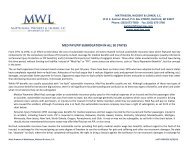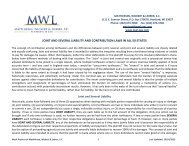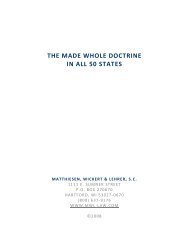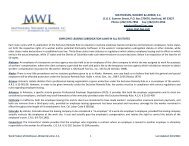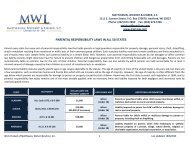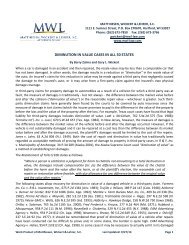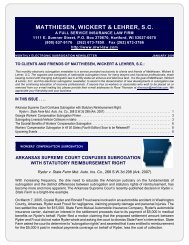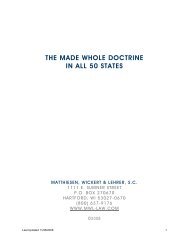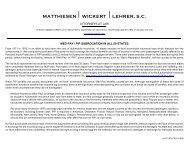Subrogation And The Seat Belt Defense (PDF) - Mwl-law.com
Subrogation And The Seat Belt Defense (PDF) - Mwl-law.com
Subrogation And The Seat Belt Defense (PDF) - Mwl-law.com
Create successful ePaper yourself
Turn your PDF publications into a flip-book with our unique Google optimized e-Paper software.
Home Articles Interviews Past Issues Advertise Blog Contact us Conferences About us Newsletter Dir<br />
SUBROGATION AND THE SEAT BELT DEFENSE<br />
Gary L. Wickert<br />
Sep 8, 2010<br />
Every state except New Hampshire requires adults to wear seat belts while traveling in a motor vehicle. Lap belts<br />
have been mandated on new vehicles since 1968. Rear outboard lap belts have been required since 1989, and<br />
shoulder harnesses since 2008. <strong>Subrogation</strong> professionals, like trial <strong>law</strong>yers, must <strong>com</strong>e face to face with an<br />
increasingly used defense within the civil justice system. In cases involving automobile accidents, even if the<br />
plaintiff/insured is totally free from negligence, not wearing a seat belt could result in a reduction of the damages the<br />
plaintiff will be allowed to recover. <strong>And</strong> with increasing frequency, it is being used by liability adjusters as an argument<br />
for significantly reducing offers of settlement. Trial <strong>law</strong>yers are also using the argument offensively and with some<br />
success. In some states, through the interplay of the Made Whole Doctrine or other state statutes, this defense could<br />
have an affect on a carrier’s rights of subrogation or reimbursement.<br />
<strong>Seat</strong> <strong>Belt</strong> <strong>Defense</strong> Generally<br />
<strong>The</strong> seat belt defense has been integrated into the <strong>com</strong>parative fault system of many states to distribute equitably the<br />
costs of first and second collision injuries on the basis of their respective causes. “First collision” injuries, of course,<br />
are the injuries resulting directly from an insured being rear-ended by a tortfeasor. “Second collision” injuries are<br />
those injuries which result inside the plaintiff’s vehicle which would not have occurred had the insured been properly<br />
wearing his or her seat belt. With a growing number of state mandatory seat belt use <strong>law</strong>s, we will see a proliferation<br />
of the seat belt defense in the <strong>com</strong>ing years.<br />
Thirty states currently have no seat belt defense in place: Alabama, Arkansas, Connecticut, De<strong>law</strong>are, Idaho,<br />
Illinois, Indiana, Kansas, Kentucky, Louisiana, Maine, Maryland, Massachusetts, Minnesota, Montana,<br />
Nebraska, New Hampshire, New Mexico, North Carolina, Oklahoma, Pennsylvania, Rhode Island, South<br />
Carolina, Tennessee, Texas, Utah, Vermont, Virginia, Washington and Wyoming. Twenty six of these states<br />
actually have <strong>law</strong>s prohibiting evidence of non-use of a seat belt - all except Idaho, Indiana and Tennessee. In most<br />
of these states, <strong>com</strong>parative fault or contributory negligence <strong>law</strong>s are in place which allows the jury to <strong>com</strong>pare the<br />
plaintiff’s negligence as <strong>com</strong>pared to the defendant. However, for example, in Maryland, state <strong>law</strong> requires that
occupants of motor vehicles wear seat belts. Transportation Art., Md. Code Ann. § 22-412.3. Nonetheless, Maryland<br />
does not consider failure to use a seat belt as contributory negligence. <strong>The</strong> accident, they feel, was caused by the<br />
negligence of the driver’s operation of the motor vehicle – NOT the plaintiff’s failure to wear a seat belt.<br />
On the other hand, 15 states do have some mechanism in place which could result in reduction of plaintiff’s damages<br />
for not having a seat belt on at the time of an accident: Alaska, Arizona, California, Colorado, Florida, Georgia,<br />
Iowa, Michigan, Missouri, New Jersey, New York, Ohio, Oregon, West Virginia and Wisconsin. <strong>The</strong>se states<br />
rationalize that while the accident itself may have been caused by the driver’s negligence, the actual injury for which<br />
damages are sought is often exacerbated by the “second collision” which occurs within the plaintiff’s vehicle as a<br />
result of his/her not wearing a seat belt.<br />
<strong>The</strong>se 15 states have adopted the seat belt defense, some by <strong>com</strong>mon <strong>law</strong> with no statutory approval, some by case<br />
decision, and some specifically by statute. <strong>The</strong>se states have provisions for allowing the introduction of evidence that<br />
the plaintiff was not wearing a seat belt in order to affect the allocation of fault by the jury or have a more structured<br />
statutory scheme which assesses fault or limits the percentage of fault which can be attributed to the failure to wear a<br />
seat belt. Clearly, a driver not wearing a seat belt and injured when his car is rear-ended by an inattentive driver can’t<br />
conceivably be 100% at fault for his injuries, but that could be the result in some states.<br />
Two states, Hawaii and North Dakota, do not have a specific statute addressing the seat belt defense but have<br />
considered it and indicated they might move toward one. <strong>The</strong> North Dakota Supreme Court, for example, has<br />
indicated that it would probably be inclined to accept the seat belt defense. Halvorson v. Voeller, 336 N.W.2d 118<br />
(N.D. 1983).<br />
Three states, Indiana, Mississippi and Nevada, do not have fully developed seat belt defense <strong>law</strong>s, because no<br />
statute or case specifically prohibits application of the seat belt defense based on a <strong>com</strong>parative negligence or failure<br />
to mitigate damages theory. State v. Ingram, 427 N.E.2d 444 (Ind. 1981); Rhinebarger v. Mummert, 362 N.E.2d 184<br />
(Ind. Ct. App. 1977); Miss. Code § 63-2-3 (1997); Roberts v. Grafe Auto Co., Inc., 701 So.2d 1093 (Miss. 1997).<br />
<strong>The</strong>re are a number of ways the seat belt defense <strong>com</strong>es into play – depending on the state. Usually, it arises under<br />
a “<strong>com</strong>parative negligence” or a “failure to mitigate damages” theory. Florida is an example of the former. Fla. Stat.<br />
Ann. § 316.614(9) (West 1997); N.Y. Vehicle and Traffic Law § 1229-c(8) (McKinney 1997). New York is an example<br />
of the latter. Spier v. Barker, 323 N.E.2d 164 (N.Y. 1974). In New York, as in most states which allow it, the seat belt<br />
defense can be submitted to the jury only if the defendant can demonstrate, by <strong>com</strong>petent evidence, a causal<br />
connection between the plaintiff’s non-use of an available seat belt and the injuries and damages sustained. In<br />
Oregon, if there is evidence from which the jury might conclude that the plaintiff’s injuries were exclusively or<br />
primarily the result of his/her failure to wear a safety belt, the jury can find that such failure to do so is not reasonable<br />
under the circumstances. Little guidance beyond this is given. Dahl v. BMW, 748 P.2d 77 (Or. 1987).<br />
<strong>The</strong> seat belt defense is controversial and is not always fair. To ameliorate its potential harshness, some jurisdictions<br />
affirmatively limit the percentage of fault which can be attributed to an otherwise-blameless driver who wasn’t wearing<br />
a seat belt. In Missouri, only 1% can be attributed to the person who failed to use a seat belt. Mo. Rev. Stat. §<br />
307.178(4). In Iowa, Michigan and Oregon, the maximum percentage is 5%. Iowa Code Ann. § 321.445(4) (West<br />
1997); Mich. Comp. Laws Ann. § 257.710(e)(6) (West 1997); Or. Rev. Stat. § 18.590 (1996). But perhaps the state<br />
with the most litigated and most clearly defined seat belt <strong>law</strong>s is Wisconsin, where the percentage is a statutory 15%.<br />
Wisconsin Stat. § 347.48(2m)(g) provides as follows:<br />
(g) Evidence of <strong>com</strong>pliance or failure to <strong>com</strong>ply with par. (b), (c) or (d) is admissible in any civil action for personal<br />
injuries or property damage resulting from the use or operation of a motor vehicle.<br />
Notwithstanding § 895.045, with respect to injuries or damages determined to have been caused by a failure to<br />
<strong>com</strong>ply with par. (b), (c) or (d), such a failure shall not reduce the recovery for those injuries or damages by more than<br />
15%.This paragraph does not affect the determination of causal negligence in the action. <strong>The</strong> fact that jurisdictions<br />
have dealt with the seat belt defense in such varying ways is testament to the defense’s controversial nature. This<br />
paper will outline some of the ways to <strong>com</strong>bat the questionable and damage-reducing seat belt defense. Part I of the<br />
paper will discuss how to legally <strong>com</strong>bat the defense in jurisdictions where the <strong>law</strong> may still not be <strong>com</strong>pletely settled<br />
on the issue. Part II will discuss how to factually <strong>com</strong>bat the seat belt defense in jurisdictions where it does exist.<br />
In California, juries are allowed to hear evidence of seat belt non-use to prove <strong>com</strong>parative fault. California Vehicle<br />
Code §27315(i), provides that “In a civil action, a violation of [the seat belt use <strong>law</strong>] does not establish negligence as<br />
a matter of <strong>law</strong> or negligence per se for <strong>com</strong>parative fault purposes, but negligence may be proven as fact without<br />
regard to the violation.” Although a violation of the California seat belt statute does not “constitute negligence as a<br />
matter of <strong>law</strong> or negligence per se,” the statute does not “totally ban use of the seatbelt statute as a factor in<br />
determining negligence.” Housley v. Godinez, 4 Cal. App.4th 737, 746 (1992). In California, for purposes of<br />
determining <strong>com</strong>parative fault, not only may the jury learn of a plaintiff’s failure to use his or her seat belt, the jury may<br />
also decide what weight, if any, to give the seat belt use statute in determining the plaintiff’s standard of reasonable<br />
care.<br />
us | Articl<br />
Issues | Adv<br />
Copyright © 200<br />
reserved. Terms of S
As mentioned in the introduction, the state of the seat belt defense is not <strong>com</strong>pletely settled in many jurisdictions<br />
including Hawaii, Indiana, Mississippi, Nevada and North Dakota. Some states seemingly cannot make up their<br />
mind on the issue. In Kentucky, § 189.125(5) overruled Wemyss v. Coleman, 729 S.W.2d 174 (Ky. 1987) so that<br />
now Kentucky does not employ the seat belt defense. In Ohio, § 4513.263(f) overruled Vogel v. Wells, 566 N.E.2d<br />
154 (Ohio 1991) so that now Ohio does not allow for application of the seat belt defense. Furthermore, the following<br />
states have adopted the seat belt defense, but only by <strong>com</strong>mon <strong>law</strong> with no statutory approval: Alaska, Arizona,<br />
Georgia and New Jersey. If you are practicing in a jurisdiction where seat belt defense <strong>law</strong> is not <strong>com</strong>pletely settled,<br />
or where it is settled only by <strong>com</strong>mon <strong>law</strong>, the following arguments may help you avoid a damaging seat belt<br />
subrogation reduction:<br />
1.<br />
2.<br />
3.<br />
Argue that the defense is not technically causative of the accident in question and can’t be considered<br />
<strong>com</strong>parative negligence because your insured’s failure to wear his or her seat belt did not help to actually cause<br />
the accident itself in any way. <strong>The</strong> traditional application of <strong>com</strong>parative negligence is that it applies only when<br />
the plaintiff’s misconduct is the “but for” cause of the accident, not the “but for” cause of the damages. Failing to<br />
wear a seat belt may have made the plaintiff’s injuries worse, but it certainly did not help to cause the accident<br />
itself. Stress that the failure to wear a seat belt cannot logically be considered <strong>com</strong>parative negligence.<br />
Argue that the seat belt defense does not logically fit into the doctrine of mitigation of damages. <strong>The</strong> traditional<br />
mitigation of damages rule states that a plaintiff has a duty to mitigate his or her damages after an accident has<br />
already occurred. Obviously, it would do a plaintiff no good to secure his or her seat belt after a car accident.<br />
Thus, failure to wear a seat belt cannot accurately be described as a plaintiff's failure to mitigate damages<br />
either.<br />
Argue that the seat belt defense runs counter to the traditional tort doctrine that defendants take their plaintiffs<br />
as they find them, also known as the “egg-shell” plaintiff’s doctrine. <strong>The</strong> plaintiff would not be assessed a<br />
percentage of fault if he or she had exceptionally brittle bones which allowed fractures to occur from a minor<br />
impact – why should it be any difference with the “seat-beltless” condition of the insured in which the defendant<br />
found the insured?<br />
4. Argue that plaintiffs should not have to anticipate other peoples’ negligence.<br />
5. Argue that a jury will have trouble speculating about what kind of damages to award a plaintiff if the seat belt<br />
defense is allowed and speculation should not play a role in causation. In other words, if the seat belt defense is<br />
asserted, juries will essentially have to guess what damages a plaintiff would have sustained with seat belt use<br />
as <strong>com</strong>pared to what they actually sustained. Even with the help of experts, this kind of calculation could<br />
be<strong>com</strong>e nothing more than mere guesswork.<br />
<strong>Subrogation</strong> and the <strong>Seat</strong> <strong>Belt</strong> <strong>Defense</strong><br />
<strong>The</strong> seat belt defense can be used to thwart legitimate subrogation interests in a number of ways. Obviously, a<br />
defense attorney or third-party liability adjuster can claim they are entitled to a significant reduction in your<br />
subrogation damages due to the failure to use a seat belt. However, plaintiff’s attorneys who have settled their cases<br />
in made whole jurisdictions can also claim that they were not made whole because they had to reduce their damages<br />
due to the application or potential application of the seat belt defense, even in otherwise clear-cut cases of defendant<br />
liability. <strong>The</strong> same arguments above should be used to counter the reasonableness of the plaintiff’s “reduced<br />
settlement.” Diligent subrogation investigation also enters the picture here.<br />
If you happen to be practicing in one of the 15 jurisdictions which allow seat belt evidence to reduce a plaintiff’s<br />
damages, it is important to know whether your client was actually wearing a seat belt or not. Obviously, you need to<br />
ask that question during your investigation, especially if this fact is not noted in the police report. It is also important to<br />
know what kind of seat belt, if any, they were wearing. <strong>The</strong> following are some issues for your consideration:<br />
1.<br />
2.<br />
If it is argued that government tests verify the efficacy and injury-reducing benefits of wearing a seat belt, you<br />
can argue with some authority that those tests are generally f<strong>law</strong>ed and cannot universally be applied to<br />
everybody. First note that many of those tests are performed using anatomical dummies which represent only<br />
50% of the population. Thus, the results of the tests are generally only valid as to 5'7", 165-pound males. Also<br />
note that the government tests are performed with the seat belts snugly secured around the dummies’ waists so<br />
as to get the maximum benefit out of the belts. Since the average person does not use a seat belt in this way,<br />
the tests cannot be representative of how seat belt use would have affected the average person, including your<br />
client, who wears his or her seat belt less formally.<br />
Look at your insured physically. A short client, for example, may sit closer than “normal” to the steering wheel.<br />
Thus, a short plaintiff, even if they wore a seat belt, may have sustained damages that an “average” person<br />
would not have sustained. Also, consider that your plaintiff may be physically heavier than others. A heavy<br />
plaintiff, even if they wore a seat belt, may have pushed the seat belt system past its maximum limits thereby<br />
making it less effective, or even ineffective.<br />
If it is alleged, by a police officer or the defense that your insured was not wearing a seat belt when they in fact were,<br />
it is certainly possible that the seat belt was simply ineffective. If your client claims to have worn a seat belt, but you<br />
are faced with a seat belt defense nonetheless, the first thing you should do is thoroughly inspect the vehicle itself to<br />
look for physical signs of seat belt use. You may want to have an expert help you perform this task. Some things to
look for include: stretch marks on the seat belt, scuffing on the belt buckle, and physical deformation of the "D-Ring"<br />
which holds the seat belt system in place at its height.<br />
In addition to checking the vehicle for physical signs of seat belt use, and possibly seat belt failure, you may want to<br />
find out if the seat belt system in question had what is known as the “Window Shade Device.” If it did, then you should<br />
explain to the defense counsel, and the jury if necessary, that the “Window Shade Device” can make seat belts less<br />
effective to the point that even if a seat belt was worn, the aftermath of an accident makes it look like there was no<br />
seat belt use. <strong>The</strong> “Window Shade Device” is a <strong>com</strong>fort feature, and arguably a defect, that is included in some seat<br />
belt systems that allow the wearer of the seat belt to introduce slack into the belt. This introduction of slack can be<br />
ac<strong>com</strong>plished intentionally or accidentally by pulling on the belt. For example, if a driver reaches forward to turn on<br />
the air conditioning, the “Window Shade Device” may introduce slack into the belt which never gets re-tightened. If a<br />
car passenger is then in an accident with a loosely fitted seat belt, it may appear as if no seat belt was worn at all. Not<br />
only is it obvious, but it has also been well documented that slack in a seat belt system seriously <strong>com</strong>promises the<br />
effectiveness of the seat belt as a whole. Thus, if your client’s seat belt system had the “Window Shade Device”<br />
feature, it is certainly possible that your client was wearing a seat belt, and that it just didn’t work.<br />
If your insured was only wearing a “lap belt,” which are often the only kinds of belts available in the back seats of cars,<br />
some studies show that your client could have actually been more injured because of seat belt use. Indeed, internal<br />
damage from the lap belt may be worse than if your client was wearing no seat belt.<br />
Conclusion<br />
<strong>The</strong> seat belt defense has emerged as one of the most controversial issues in recent tort <strong>law</strong> history. Although a clear<br />
majority of jurisdictions have rejected the defense, a substantial number of large and influential states, including New<br />
York, California and Florida, have adopted at least some version of it. As the controversial doctrine establishes itself<br />
more firmly, there are sure to be new issues relating to its application to subrogation claims. <strong>The</strong> very fact that you are<br />
familiar with the seat belt defense, its applicability in a particular jurisdiction, and some rather cutting-edge arguments<br />
with which to diffuse it, will go a long way in bolstering your negotiating strength and your overall subrogation<br />
recovery.<br />
For <strong>law</strong>s or particulars relating to a specific state’s seat belt <strong>law</strong>s or the existence of a seat belt defense, please feel<br />
free to contact Gary Wickert at gwickert@mwl-<strong>law</strong>.<strong>com</strong><br />
About <strong>The</strong> Author<br />
Gary L. Wickert<br />
(262) 673-7850<br />
1111 E. Sumner Street<br />
gwickert@mwl-<strong>law</strong>.<strong>com</strong><br />
P.O. Box 270670<br />
gwickert@mwl-<strong>law</strong>.<strong>com</strong><br />
www.mwl-<strong>law</strong>.<strong>com</strong><br />
Hartford, Wisconsin 53027-0670<br />
Gary Wickert is an insurance trial <strong>law</strong>yer and is regarded as one of the world’s leading experts<br />
on insurance subrogation. He is the author of several subrogation books and legal treatises and is a national and international<br />
speaker and lecturer on subrogation and motivational topics. Gary is also a published <strong>com</strong>mercial fiction author and a politician<br />
in Wisconsin. After 15 years as the youngest managing partner in the history of the 30-<strong>law</strong>yer Houston <strong>law</strong> firm of Hughes,<br />
Watters & Askanase, L.L.P., Gary returned to his native Wisconsin in 1998 and co-founded the subrogation firm of Matthiesen,<br />
Wickert & Lehrer, S.C. He oversees a National Recovery Program which includes a network of nearly 300 contracted<br />
subrogation <strong>law</strong> firms in all 50 states, Mexico, Canada and the United Kingdom and boasts more than $500 million in recoveries<br />
and credits for more than 250 insurance <strong>com</strong>panies since 1983. Licensed in both Texas and Wisconsin, Gary is double boardcertified<br />
in both personal injury <strong>law</strong> and civil trial <strong>law</strong> by the Texas Board of Legal Specialization. He is also certified as a Civil<br />
Trial Advocate by the National Board of Trial Advocacy, for whom he has both written and graded product liability questions<br />
contained on the NBTA national certification exam taken by trial <strong>law</strong>yers around the country. For more than 25 years, Gary has<br />
served as an expert witness and insurance consultant on subrogation and insurance related issues and has been consulted by<br />
insurance carriers, <strong>law</strong>yers, and legislative bodies from several states. He is a licensed arbitrator and has attended more than<br />
750 mediations in more than 30 different states. He is one of only a few <strong>law</strong>yers to have ever appeared before the United States<br />
Supreme Court on a subrogation issue, and was named as one of Law & Politics and Milwaukee Super Lawyers’ magazine’s<br />
Super Lawyers from 2005 to 2010.



